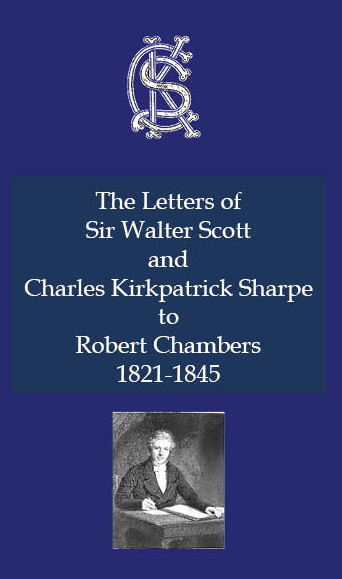|
|

 Home |
Catalogue |
Order |
About
Home |
Catalogue |
Order |
About
|

|
|
The Letters of Sir Walter Scott and Charles Kirkpatrick Sharpe to Robert Chambers 1821-1845
| |
| Sir Walter Scott and Charles Kirkpatrick Sharpe |
| ISBN 9781849210614 |
| SERIES Charles Kirkpatrick Sharpe Collection |
| Paperback 86 pages |
| |
| Published 30 September 2010
UK Price £9.95
US Price $15.00 |
The early life of Robert Chambers embracing the period of his connection with Sir Walter Scott has already been described by his brother William in the Memoir of himself.
"But while Dr William Chambers had access to many early papers now in my possession, he made little use of these, and printed no letters of this period.
The letters of Sir Walter Scott printed in the Memoir of William and Robert Chambers (1872) were written at a later date, and have no reference to that subject which first awakened in the great man sympathy for a young and struggling literary aspirant.
With the exception of the above-mentioned letters, any extracts now printed from Scott manuscripts belonging to me appear for the first time. "
One of these papers, recently discovered, is the first portion (incomplete) of a History of the Canongate, and may have formed part of that work on the antiquities of Edinburgh which Scott, in collaboration with Mr Skene of Rubislaw, had at one time intended to write.
After seeing the first two parts of Robert Chambers's Traditions of Edinburgh, Scott's original idea -- as we are told by the author in his Preface to the last revised edition -- was abandoned, and many of his notes handed on to his youthful protégé and friend.
The same Preface makes it no less clear that, besides Sir Walter Scott, Robert Chambers was equally indebted to Charles Kirkpatrick Sharpe for much valuable information.
The series of letters from Mr Sharpe now printed, while slight and unimportant in themselves, are at the same time curious and original, besides being typical of the man himself, as described by contemporaries.
Robert Chambers's account of Charles Kirkpatrick Sharpe is very striking, and gives a better idea of this eccentric genius than is to be found in any biography.
It reads as follows: "Looking back from the year 1868, I feel that C. K. S. has himself become, as it were, a tradition of Edinburgh.
"His thin, effeminate figure, his voice pitched in alt. -- his attire, as he took his daily walks on Princes Street: a long blue frock-coat, black trousers (rather wide below, and sweeping over white stockings and neat shoes), something like a web of white cambric round his neck, and a brown wig coming down to his eyebrows-had long established him as what is called a character.
"He had recently edited a book containing many stories of diablerie, and another in which the original narrative of ultra-presbyterian Church History had to bear a series of cavalier notes of the most mocking character.
"He had a quaint, biting wit, which people bore as they would a scratch from a provoked cat.
"Essentially, he was good-natured and fond of merriment. He had considerable gifts of drawing, and one caricature portrait by him, of Queen Elizabeth dancing, " high and disposedly," before the Scotch ambassadors, is the delight of everybody who has seen it."
|
|
|
|
|
© Kennedy & Boyd, an imprint of Zeticula Ltd., Unit 13, 196 Rose Street, Edinburgh, EH2 4AT, Scotland
|
| |
| |